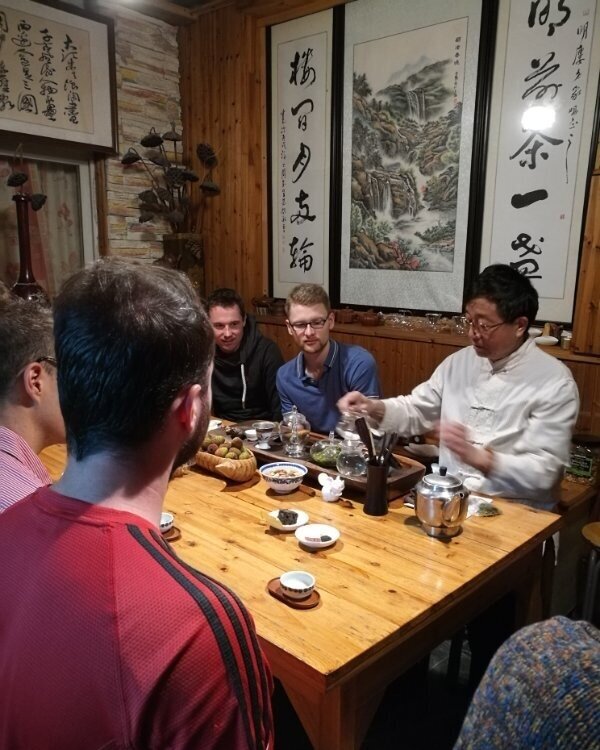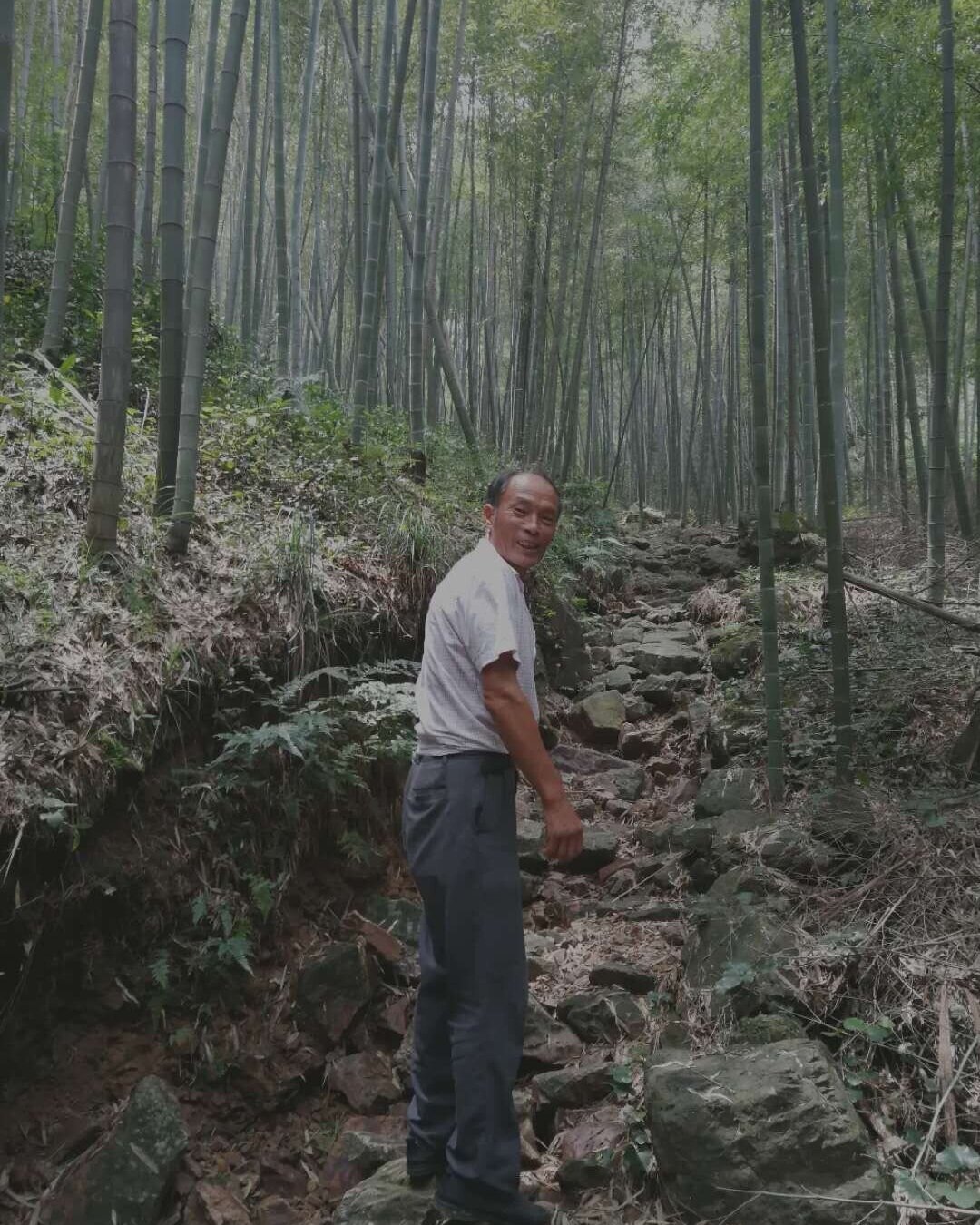GU ZHU PURPLE BAMBOO
Gu Zhu Purple Bamboo, a.k.a. Gu Zhu Zi Sun 顾诸紫笋 is a green tea from Gu Zhu Mountain in Chang Xing County of Zhe Jiang, China. Carries the longest fame as a tribute tea and had been neglected for over three hundred years, new story continues now.
‘Gu Zhu’ is the name of the mountain, ‘Zi’ describes the purple color of the young shoots and ‘bamboo’ represents its shape of the buds. Being surrounded with rolling hills bamboo forests in the area, there is no coincidence that some think ‘bamboo’ also resembles part of its character comparable to the taste of the fresh bamboo all the locals favor. It delivers a super light brew with noticeable orchid aroma and sweetness. Its savory taste and lingering aftertaste make it more special to lovers of it.
Roadside tea tasting
Purple shoots of the Gu Zhu Zi Sun, the purple color will slowly disappear while the leave matures.
Branching out from Tian Mu Mountain in eastern part of China, Tai Lake to its east, Gu Zhu Mountain is hugged on the other three sides with mountains, which creates the frequent clouds and fogs in the area, an ideal environment for tea with savory note and less caffeine. The less fortunate part is that it has always been a target during power shifts due to its geographic location. Meanwhile, refugees, immigrates, literals and hermits had found here a safe heaven though, at least temporarily, through the long narrow pathways in between different mountains. In fact, locals whose family has been lived there since 19th Century can still point out effortlessly where outside of the area the exiting pathways lead to. These pathways are called Ka and used to identify the location of where the tea grows in the region by locals.
Among many who stayed, Lu Yu (733-804 AD) was one of them and it almost seems impossible not to give him credits when we talk about Gu Zhu Zi Sun. He is regarded as one of the tea saint in China and lived during the Tang Dynasty. Lu Yu moved here and spent more than two decades to write “The Classics of Tea”, which is the first known monograph on tea in the world.
Where exactly he moved to in 760 AD is debatable but he did spend a long time traveling and researching in Gu Zhu Mountain. Besides the Classics of Tea, he also wrote a journal about the Gu Zhu Mountain. In 766 AD, local official introduced him to this tea from the monastery on the Gu Zhu Mountain. He liked the tea very much and named it Gu Zhu Zi Sun. He suggested this to be sent to the court with Yang Xian Cha which is already a Tribute Tea, from Yi Xing, where now it is more known for its Yi Xing clay pot. In 770 AD, 30 huts were built to make sure the teas are processed to meet certain standards, which Lu Yu took part in monitoring it for a while and Gu Zhu Mountain became the Royal Tea Garden…Gu Zhu Zi Sun had became the tribute tea ever since then until 1375 AD when it was prohibited by the Ming Emperor.
The glorious time had been passed. The land almost went barren for the next 300 years due to constant wars and diseases.
Early 1970s, there were state-owned tea shops in China where you could find all sorts of teas produced in China. Chen Ming Lou would get one jar of tea there, finished the whole thing and then went back to get another jar of different kind. He tried Gu Zhu Zi Sun first time after his dad, who is also a tea lover, received the tea as a gift from a friend in Chang Xing. At that time, locals there started to experimenting how to grow Zi Sun tea again on the Gu Zhu Mountain.
Chen started to share this tea with his friends in college before he eventually decided to visit Chang Xing in 1979. Since then, he has been going there every spring to get his favorite Gu Zhu Zi Sun.
Chen tried to cross the bamboo just fell down a couple of days ago.
I have known Chen for 15 years since the time I started getting into tea in Shanghai and I enjoyed the tea every time I visited him at his hut. I am amazed throughout all those years, regardless the booming of the tea industry, he is still operating his cozy joint liEarly 1970s, there were state-owned tea shops in China where you could find all sorts of teas produced in China. Chen Ming Lou would get one jar of tea there, finished the whole thing and then went back to get another jar of different kind. He tried Gu Zhu Zi Sun first time after his dad, who is also a tea lover, received the tea as a gift from a friend in Chang Xing. At that time, locals there started to experimenting how to grow Zi Sun tea again on the Gu Zhu Mountain.
Chen started to share this tea with his friends in college before he eventually decided to visit Chang Xing in 1979. Since then, he has been going there every spring to get his favorite Gu Zhu Zi Sun.
Chen tried to cross the bamboo just fell down a couple of days ago.
I have known Chen for 15 years since the time I started getting into tea in Shanghai and I enjoyed the tea every time I visited him at his hut. I am amazed throughout all those years, regardless the booming of the tea industry, he is still operating his cozy joint like the old time.
Being aware of how much knowledge he has with the tea, especially with Gu Zhu Zi Sun and how much he wants to share his love for it with other people, I went on a trip with Chen this summer. ke the old time.
Being aware of how much knowledge he has with the tea, especially with Gu Zhu Zi Sun and how much he wants to share his love for it with other people, I went on a trip with Chen this summer.
Chen was sharing Gu Zhu Zi Sun with visiting students from Germany.
Chen tried to cross the bamboo just fell down a couple of days ago.
Luo was the first local we met when we got to Chang Xing. In addition to tea, he grows seasonal vegetables like lily roots and kiwi as well. They were in season in the summer. When I met him, he just came back from a delivery to a nearby city, a couple hours’ drive away. He hiked with us into the mountain to locate his tea.
Luo showed us a couple of spots where his tea is growing. When I asked “How many times a year do you harvest your tea?” he laughed out loud. They only pluck the tea once a year simply because they don’t have time to do that. He pointed out the teeth marks on the tea seeds. “Dried tea seeds attract mice. They chew on them, leave them around and some tea start grow wildly too” . Aha…
The area Luo took us is covered with rocks in various shapes, small and large, and the foliages make it even trickier to move around, but this environment is just what the tea needs. Both the rocks and foliages prevent the loss of soil and maintain the level of the moisture and temperature in the soil.
We ended our time with Luo with a ‘farm-to-table’ meal cooked by Luo’s brother. With no famous chef nor fancy setting, but it was truly tasteful with enough that nature is offering us from the mountain.
Luo was telling us that he unconsciously lifted his feet high even walking in the city. A habit growing up in the mountain.
Jin is another farmer we met. She runs a farm stay while she takes care of the teas, plum and pears trees with her husband in the mountain… We had a little tea tasting session in her back yard and were able to cool down a bit in the summer heat. She brought out tables and chairs, even fans. Her 90-year-old grandma and some guests joined us. The watermelon and locally grown dragon fruit they offered went surprisingly well with the tea.
Jin’s tea are growing on the sloppy hills here. I didn’t have a easy time maneuvering around here. The thick layers of bamboo leaves were so slippery that I could barely stand still on it. Imagine picking up tea leaves here!
Most of the local tourists stop at the bottom of the mountain. There is only the sound of cicadas, birds, swishing sound of the bamboo leaves and our foot steps on them…I wonder whether I was experiencing the similar tranquility as all those who walked through here before
Getting down from her tea gardens. Jin was reminding me to watch my steps. The thick layers of bamboo leaves makes it super slippery and the dried bamboo sticks are pointy.
Summer 2018






